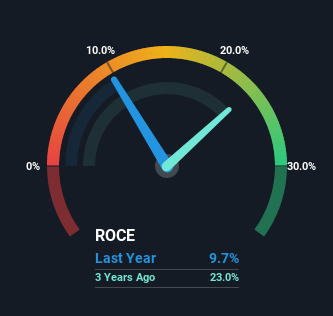Returns On Capital Signal Tricky Times Ahead For Inghams Group (ASX:ING)
If you're not sure where to start when looking for the next multi-bagger, there are a few key trends you should keep an eye out for. Firstly, we'll want to see a proven return on capital employed (ROCE) that is increasing, and secondly, an expanding base of capital employed. Ultimately, this demonstrates that it's a business that is reinvesting profits at increasing rates of return. However, after investigating Inghams Group (ASX:ING), we don't think it's current trends fit the mold of a multi-bagger.
Return On Capital Employed (ROCE): What is it?
For those that aren't sure what ROCE is, it measures the amount of pre-tax profits a company can generate from the capital employed in its business. To calculate this metric for Inghams Group, this is the formula:
Return on Capital Employed = Earnings Before Interest and Tax (EBIT) ÷ (Total Assets - Current Liabilities)
0.097 = AU$180m ÷ (AU$2.6b - AU$730m) (Based on the trailing twelve months to December 2021).
Thus, Inghams Group has an ROCE of 9.7%. In absolute terms, that's a low return, but it's much better than the Food industry average of 6.6%.
Check out our latest analysis for Inghams Group

In the above chart we have measured Inghams Group's prior ROCE against its prior performance, but the future is arguably more important. If you'd like, you can check out the forecasts from the analysts covering Inghams Group here for free.
What Can We Tell From Inghams Group's ROCE Trend?
On the surface, the trend of ROCE at Inghams Group doesn't inspire confidence. Over the last five years, returns on capital have decreased to 9.7% from 20% five years ago. However it looks like Inghams Group might be reinvesting for long term growth because while capital employed has increased, the company's sales haven't changed much in the last 12 months. It's worth keeping an eye on the company's earnings from here on to see if these investments do end up contributing to the bottom line.
The Bottom Line
In summary, Inghams Group is reinvesting funds back into the business for growth but unfortunately it looks like sales haven't increased much just yet. And with the stock having returned a mere 19% in the last five years to shareholders, you could argue that they're aware of these lackluster trends. So if you're looking for a multi-bagger, the underlying trends indicate you may have better chances elsewhere.
If you want to know some of the risks facing Inghams Group we've found 3 warning signs (1 shouldn't be ignored!) that you should be aware of before investing here.
While Inghams Group isn't earning the highest return, check out this free list of companies that are earning high returns on equity with solid balance sheets.
New: AI Stock Screener & Alerts
Our new AI Stock Screener scans the market every day to uncover opportunities.
• Dividend Powerhouses (3%+ Yield)
• Undervalued Small Caps with Insider Buying
• High growth Tech and AI Companies
Or build your own from over 50 metrics.
Have feedback on this article? Concerned about the content? Get in touch with us directly. Alternatively, email editorial-team (at) simplywallst.com.
This article by Simply Wall St is general in nature. We provide commentary based on historical data and analyst forecasts only using an unbiased methodology and our articles are not intended to be financial advice. It does not constitute a recommendation to buy or sell any stock, and does not take account of your objectives, or your financial situation. We aim to bring you long-term focused analysis driven by fundamental data. Note that our analysis may not factor in the latest price-sensitive company announcements or qualitative material. Simply Wall St has no position in any stocks mentioned.
About ASX:ING
Inghams Group
Engages in the production and sale of chicken and turkey products under the Ingham’s brand primarily in Australia and New Zealand.
Undervalued with reasonable growth potential and pays a dividend.
Similar Companies
Market Insights
Community Narratives




